It’s not often an RTS event is held in total darkness — and yes, the imagined pictures were vivid enough to make the scalp tingle.
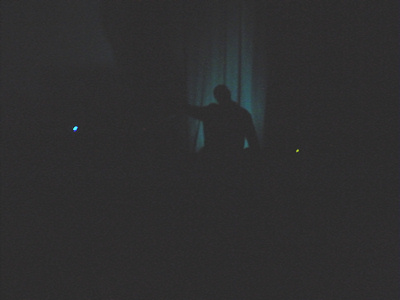
The power of sound was evoked in a masterclass attended by 150 people — many more were on the waiting list — at Newcastle University’s CultureLab.
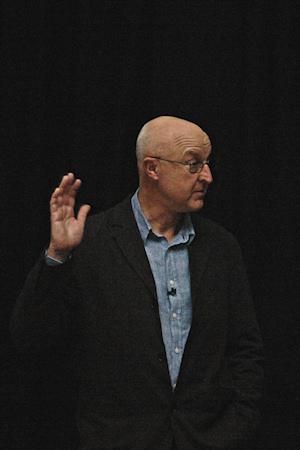 And the maestro with the mic was BAFTA award-winning Chris Watson, whose love of sound has resulted in a varied career making recordings from the South Pole to African safari parks, for primetime TV (such as Springwatch) to Radio Four documentaries, to film, videogame soundtracks, sound installations, CDs and musical performance. “The great thing about sound is that it’s enabled me to work across all these platforms.”
And the maestro with the mic was BAFTA award-winning Chris Watson, whose love of sound has resulted in a varied career making recordings from the South Pole to African safari parks, for primetime TV (such as Springwatch) to Radio Four documentaries, to film, videogame soundtracks, sound installations, CDs and musical performance. “The great thing about sound is that it’s enabled me to work across all these platforms.”
It all began at Tyne Tees Television in 1981; Chris paid tribute to the techniques of layering he learnt from the skilled post production team there, and which he still uses today. A sabbatical to the RSPB film unit gave him the chance to develop his skills on the road and learn how vital sound tracks are to storytelling.
Since then he’s pushed the boundaries and urges R&D (“painfully slow, a decade behind visuals, yet very little in cost”) to push them much further again. One aim was “to take the microphone where we can’t put our ears”. He realised that the visual impact of top range zoom lenses — achieving dramatic close-ups of wildlife — were simply not emulated by sound. So he set out to make that happen; “I began to hear things I’d never heard before, it fired my imagination”.
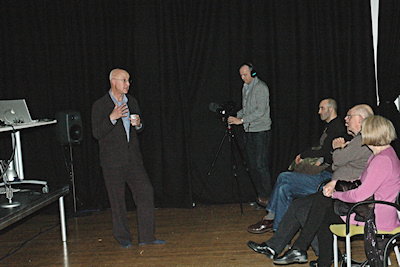
A stunning example was his recording of the resonant sounds of a cheetah purring just a few inches away — achieved by hours of patience near a sleepy big cat in Kenya. You felt in the darkness this huge creature was breathing down your neck.
The beach at Blyth near his Northumberland home illustrated the same point. The familiar sounds of the waves were transformed by lowering his hydrophone just an inch or two below the surface — we were in a different world.
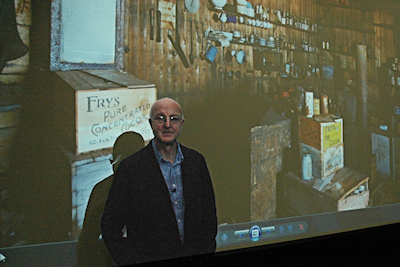
Chris with a slide of the interior of Scott's cabin
The same technique revealed astonishing contrasts in the Antarctic when recording Frozen Planet. Above the ice was the silence of an ice and snow world stretching a thousand miles. Yet lower the hydrophone just below the surface in an ice hole, and we were treated to the songs of the Weddell seals and the complex language of a pod of Orca — killer whales which are the world’s largest predators. Sound travels five times further in water — even an icebreaker passing 20 kilometres away will disturb the wildlife. “On the surface we hear nothing — but it’s human arrogance to call it silent, with all that sound inches away.”
And within glacier crevasses was what Chris called the “amazing musicality, like 1950s electronic music” created by the enormous hidden forces at work, as far-off volcanic activity forced the ice on its way to the sea, and the “metallic metronome” of melting ice.
But we don’t have to be adventurers to wallow in wonderful audio. Local Northumberland again provided the haunting calls of the grey seal mothers and the song of the blackbird: “it doesn’t get any better than that.”
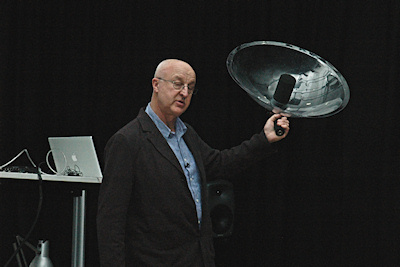
The many audience questions included discussion on the technical kit Chris used — his standard kit includes small omni-directional mics and his parabolic reflector; a robust item which focuses the sound from a particular spot and achieves tremendous acoustic amplification superior to any digital trickery. But at low temperatures there were many extra challenges — “cables snap like liquorice”.
With a whole world of sound to be discovered and shared, broadening our understanding of life on our planet, there was a final irony. The unique recordings made for Frozen Planet were not heard, but replaced by music. Chris has preserved these and many other amazing aural experiences in his ever-growing archive.
He made a plea that audiences are not denied this rich resource: “The red button should provide a music-free option.” As a final treat he revealed that the BBC had quietly posted an experimental surround sound version of Carols at Kings on iPlayer. If you want to sample it, search for the BBC blog “The Festival of Nine Lessons and Carols in surround sound”. And you can enjoy Chris’ own work on www.chriswatson.net.
OLWYN HOCKING
* “Natural Sound: RTS Masterclass with Chris Watson” was a followup event to the RTS North East and the Border Centre 2011 presentation “Extreme Filming”.

